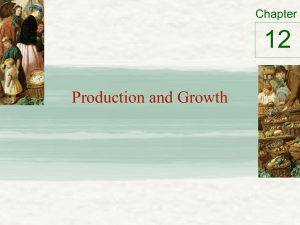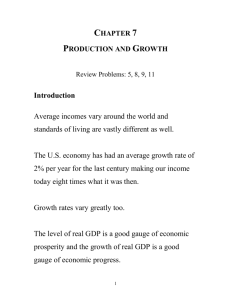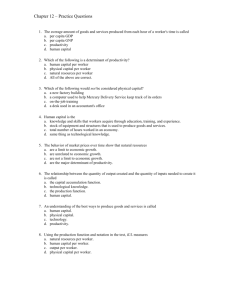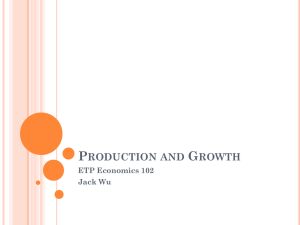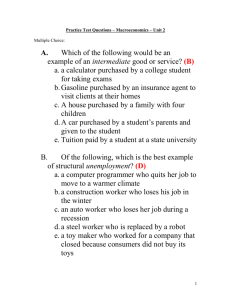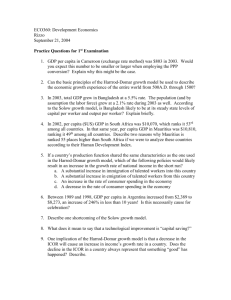Chap 12 - Determinants of GDP and growth in GDP
advertisement
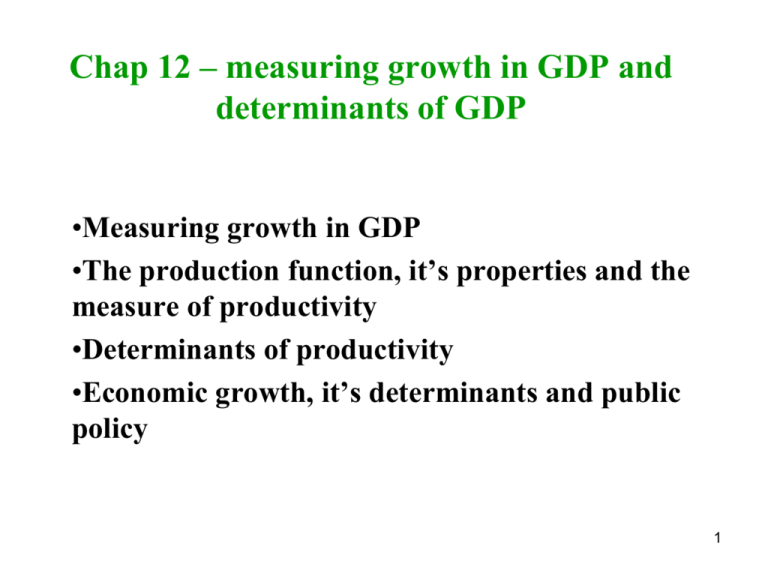
Chap 12 – measuring growth in GDP and determinants of GDP •Measuring growth in GDP •The production function, it’s properties and the measure of productivity •Determinants of productivity •Economic growth, it’s determinants and public policy 1 I. Measuring growth in GDP Compounding refers to the growth rate from the year (t – 1) to the year t is measured as, g= where Yt represents output at time t. Equation can be written as Assuming g to be constant over all years, starting from an initial year 0, after T years, output becomes, Even if g and Y0 are small, YT can become very large if 2 . The Variety of Growth Experiences Country Period Real GDP per Real GDP per Person at Person at End Beginning of Period of Period Growth Rate (per year) Japan 1890-1997 $1,196 $23,400 2.82% Brazil 1900-1990 619 6,240 2.41 Mexico 1900-1997 922 8,120 2.27 Germany 1870-1997 1,738 21,300 1.99 Canada 1870-1997 1,890 21,860 1,95 China 1900-1997 570 3,570 1.91 Argentina 1900-1997 1,824 9,950 1.76 United States 1870-1997 3,188 28,740 1.75 Indonesia 1900-1997 708 3,450 1.65 United Kingdom 1870-1997 3,826 20,520 1.33 India 1900-1997 537 1,950 1.34 Pakistan 1900-1997 587 1,590 1.03 Bangladesh 1900-1997 495 1,050 0.78 3 Figures in column 5 are calculated as follows: for Japan, 23,400 = 1,196 (1 + g)107. The solution of g for this equation is 2.82%. Growth rates are not usually Doubling time of the level of output According to the rule of 70, if some variable grows at a rate of x percent per year, then that variable doubles in approximately 70/x years. $5,000 invested at 7 percent interest per year, will double in size in 10 years, because 70/7 = 10 4 II and III. The Production Function, its properties and the determinants of productivity Y = A F(L, K, H, N) Y = quantity of output A = available production technology L = quantity of labor K = quantity of physical capital H = quantity of human capital N = quantity of natural resources F( ) is a function that shows how the inputs are combined. 5 productivity (more precisely labor productivity) is defined as Determinants of labor productivity: 1. Capital per worker 2. Human capital per worker 3. Natural resource per worker 4. Technology 6 The Production Function • A production function has for any positive number x, if, xY = A F(xL, xK, xH, xN) • • That is, a output Setting x = , of all inputs causes the amount of . Y/ L = A F(1, K/ L, H/ L, N/ L) where, Y/L = output per worker, K/L = physical capital per worker, H/L = human capital per worker, N/L = natural resources per worker 7 IV. Economic growth, it’s determinants and public policy Determinants: 1. domestic savings and investment To increase physical capital stock for the future, society must role of financial markets: financial markets bring together diminishing returns (catch-up effect) and limits on growth all factors of production, in particular capital is subject to Geometrically, the production function in the per worker form 8 2. foreign investment foreign direct investment foreign portfolio investment effect on GDP and growth 3. education or investment on human capital Human capital generates a . . Hence brain drain creates Public policies subsidizing education 9 4. Health and nutrition 5. property rights and political stability 6. free trade 10 7. Fostering R & D 8. Managing population growth 11



